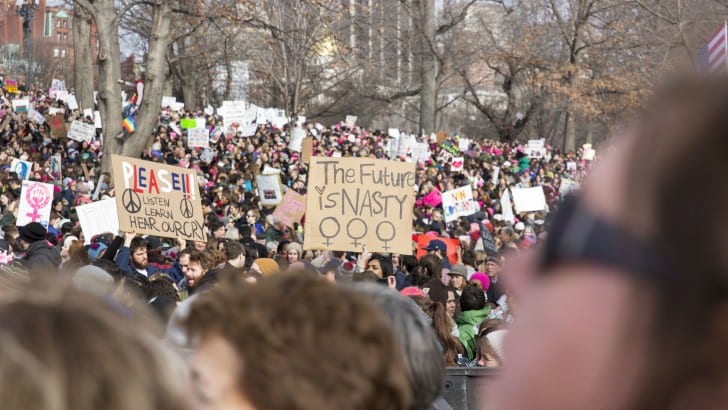
Photo by Scott Murry
January 24, 2017
BY JASON PRAMAS @JASONPRAMAS
The Boston Women’s March for America was a tremendous success by any metric. Likely the largest political demonstration in the city’s history, its estimated 175,000 attendees made it big enough to dwarf even many national demonstrations of the last many years. Which shows two important things. First, there are a great many Massachusetts residents ready to fight to bring down the Trump administration. Second, the state’s population is strongly in favor of women’s rights—and a number of other positions mentioned in the event’s mission statement, including: racial justice, economic justice, human rights, climate justice, and religious freedom. So, credit where credit is due, march organizers did a wonderful job of reading the political moment, and turning out the broad left against a clear and present threat to democracy … in the form of a triumphalist hard right wing of the Republican Party.
However, the local march and hundreds of related actions across the US last weekend—up to and including the main Washington, DC march—all had an inherent political flaw that’s going to be hard to overcome. That is, their organizers appear to have no follow-up plan beyond mobilizing voters to get the Democrats back in power.
This is because the progressive nonprofits and labor unions behind the marches themselves have no high-level strategy beyond that same goal. Which is why many of them could not even support Bernie Sanders, their party’s credible left alternative in last year’s election. And why the Dems are not much better than the Repubs on a host of key issues—and in some cases, as with the Trans Pacific Partnership that President Trump just shot down as a first order of business, they are worse. Because the organizations that comprise the progressive wing of the Democrats, and provide most of its grassroots muscle, continue to refuse to challenge the still-dominant pro-corporate Clintonite wing of the party for control of its platform.
Given that problematic background, it’s easy to understand why the marches were essentially transformed into giant launchpads for the candidacies of key Democratic politicians for the 2018 and 2020 elections. In Boston, for example, the main speaker was Sen. Elizabeth Warren—a clear contender for the 2020 Democratic presidential nomination, having stood down in the recent election and consolidated her power base. Other rising Democratic politicians like Mass Attorney General Maura Healey, Boston Mayor Marty Walsh, and Boston City Councilor and City Council President Michelle Wu also mounted the podium—and none could ask for a better campaign kickoff for their next races. Whatever those races may be.
But electing more Democrats to office is not going to solve the problems this nation is facing. Especially if the party continues to be led elitist technocrats who fake left, but break right on all the issues that matter to its populist wing.
An otherwise decent progressive like Warren will keep pulling her punches on effective policy prescriptions like single-payer national healthcare, and continue to defend Obamacare when she herself has written in favor of single-payer as the “most obvious solution” to our health crisis. Because she doesn’t have the support of party leadership to take on corporate power.
A union-backed mayor like Walsh will continue to base his economic policies on the simple conceit of attracting as many major corporations to Boston as possible—as he did by supporting the GE Boston Deal—in the likely vain hope that doing so will somehow result in more decent jobs for his working and middle-class constituents. Instead of creating public jobs programs and building large amounts of public housing like big city Democratic pols from the 1930s to the 1960s. Pushed by an ascendant and militant labor movement for much of that period. Because, again, he doesn’t have the support of party leadership for such policies. And because today’s union and nonprofit leaders have been unwilling to push Democrats to back the democratic socialist policies that many of them privately believe in.
So that’s the strategic quandary that progressive Democrats of the type who just pulled off huge and successful mass mobilizations find themselves in. They know perfectly well that a society run by and for the rich is incompatible with the fairness and justice they seek. They know that we cannot solve all the dire problems facing America by handing the reins of power to the CEOs—as both major parties have been doing for decades—and hoping for the best. And they know that the best organizing isn’t top-down, but is instead horizontal and, well, democratic.
Yet even when they pull millions into a great event like the marches against President Trump, they remain afraid to let the grassroots they just inspired to action run the political movement they hope to build. And as long as that cycle continues, the Democratic Party might indeed return to power by 2020. But all the marches in the world won’t bring true democracy to the United States.
Apparent Horizon is syndicated by the Boston Institute for Nonprofit Journalism. Jason Pramas is BINJ’s network director.
Copyright 2017 Jason Pramas. Licensed for use by the Boston Institute for Nonprofit Journalism and media outlets in its network.
Check out the Apparent Horizon Podcast on:
iTunes, Google Play Music, Blubrry, Stitcher, TuneIn, and YouTube
